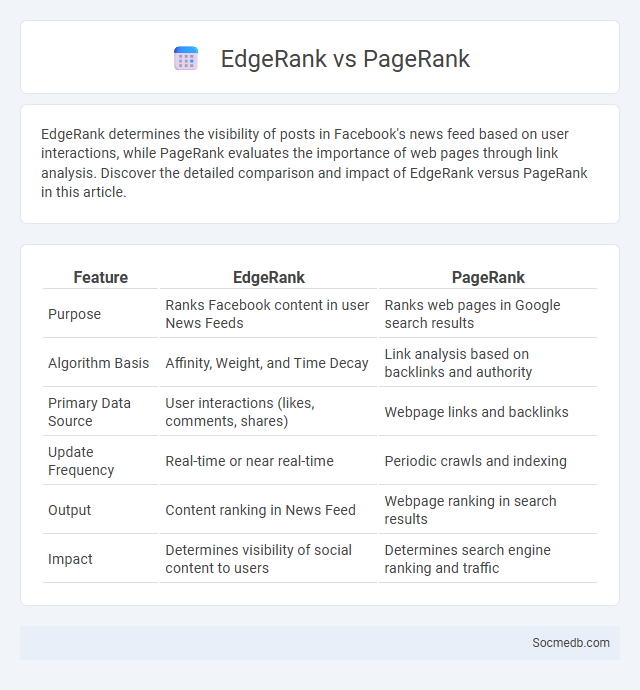
Photo illustration: EdgeRank vs Pagerank
EdgeRank determines the visibility of posts in Facebook's news feed based on user interactions, while PageRank evaluates the importance of web pages through link analysis. Discover the detailed comparison and impact of EdgeRank versus PageRank in this article.
Table of Comparison
| Feature | EdgeRank | PageRank |
|---|---|---|
| Purpose | Ranks Facebook content in user News Feeds | Ranks web pages in Google search results |
| Algorithm Basis | Affinity, Weight, and Time Decay | Link analysis based on backlinks and authority |
| Primary Data Source | User interactions (likes, comments, shares) | Webpage links and backlinks |
| Update Frequency | Real-time or near real-time | Periodic crawls and indexing |
| Output | Content ranking in News Feed | Webpage ranking in search results |
| Impact | Determines visibility of social content to users | Determines search engine ranking and traffic |
Understanding EdgeRank: The Facebook Algorithm
EdgeRank is Facebook's algorithm that determines the visibility of posts in users' News Feeds by evaluating three key factors: affinity, weight, and time decay. Affinity measures the relationship strength between the user and the content creator, weight assigns importance based on the type of interaction such as comments, likes, or shares, and time decay prioritizes newer posts over older ones. Mastering EdgeRank optimization enhances organic reach, engagement rates, and content performance on the Facebook platform.
PageRank Explained: Google’s Link Analysis
PageRank is a fundamental algorithm developed by Google that ranks web pages based on the quantity and quality of links pointing to them, significantly impacting your social media content's visibility and search engine ranking. It evaluates the authority and relevance of a page by analyzing incoming links, treating them as votes that signal trustworthiness and importance in the digital ecosystem. Understanding PageRank helps you optimize link-building strategies on social platforms, enhancing your online presence and driving organic traffic through improved search results.
EdgeRank vs. PageRank: Key Differences
EdgeRank and PageRank are algorithms used by Facebook and Google, respectively, to prioritize content visibility in social media and search results. EdgeRank calculates content relevance through factors such as user interaction, content type, and recency, determining what appears in your Facebook News Feed. PageRank evaluates the quality and quantity of links to a webpage, influencing your website's ranking in Google search results based on authority and relevance.
How EdgeRank Shapes Social Media Feeds
EdgeRank, Facebook's algorithm, determines the visibility of posts in users' social media feeds by scoring content based on affinity, weight, and time decay. Higher affinity between users and content creators, combined with engaging post types such as videos and photos, increases a post's EdgeRank score, thus boosting its prominence in the feed. Timely interactions and consistent engagement patterns further enhance the likelihood of content being prioritized, shaping personalized and relevant social media experiences.
PageRank’s Impact on Search Engine Results
PageRank significantly influences search engine results by measuring the authority and relevance of web pages based on link quality and quantity. Your website's visibility improves when high-ranking pages link to it, boosting its overall PageRank score. Optimizing social media strategies to generate valuable backlinks can enhance your site's search engine positioning effectively.
Algorithm Evolution: EdgeRank 2.0 and Beyond
Social media algorithms have evolved significantly from Facebook's original EdgeRank to EdgeRank 2.0, which incorporates more complex factors like user interaction, content type, and recency to enhance personalized content delivery. Modern platforms use machine learning and artificial intelligence to analyze user behavior patterns, enabling more accurate prediction of content relevance and engagement potential. Continuous algorithm updates focus on prioritizing meaningful interactions while combating misinformation and promoting diverse content exposure.
Comparing Influence: Engagement vs. Link Authority
Engagement metrics on social media, such as likes, comments, and shares, directly reflect your audience's interaction and brand loyalty, driving immediate visibility and community growth. Link authority, measured by the quality and relevance of external backlinks, enhances your website's SEO by boosting its credibility and ranking on search engines. Balancing high user engagement with strong link authority maximizes your overall digital influence and long-term online presence.
Optimizing Content for EdgeRank and PageRank
Optimizing content for EdgeRank and PageRank requires a strategic approach focused on user engagement and relevance. Creating high-quality, shareable posts with targeted keywords enhances visibility across social media platforms and search engines. Incorporating multimedia elements like images and videos boosts interaction rates, positively influencing algorithmic rankings and driving organic traffic.
Measuring Success: Metrics for EdgeRank and PageRank
EdgeRank and PageRank are critical algorithms for measuring social media success by evaluating user engagement and website authority, respectively. Key metrics for EdgeRank include likes, comments, shares, and post frequency, which influence content visibility in Facebook's news feed. PageRank relies on the quantity and quality of backlinks, page relevance, and content authority to determine search engine ranking and drive organic traffic.
Future Trends: The Next Generation of Ranking Algorithms
Future social media ranking algorithms will increasingly rely on artificial intelligence and machine learning to deliver personalized content, optimizing user engagement and retention. These next-generation algorithms will prioritize context-aware analysis, understanding user intent, sentiment, and multimedia elements such as images and videos for more accurate content ranking. Privacy-preserving techniques like federated learning will also play a crucial role in balancing personalization with data security, shaping the evolution of ranking systems in social platforms.
 socmedb.com
socmedb.com